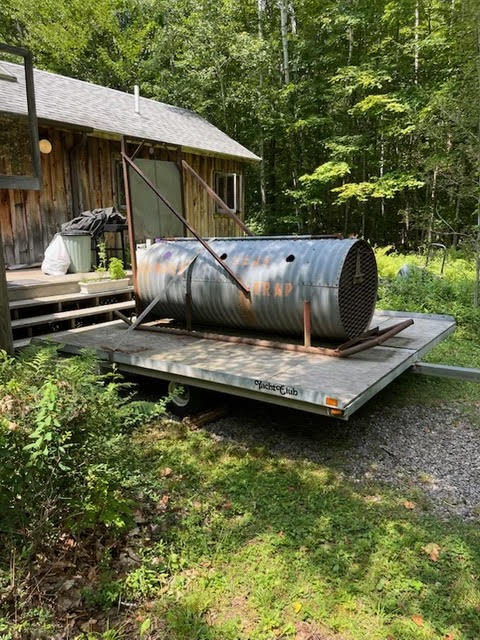By Richard Knox
On Wednesday night the New Hampshire Fish & Game Department trapped a black bear on Eastman (formerly Squaw) Cove after the beast had invaded two camps in the neighborhood — in one case twice over a 2-day period.
The bear had been hanging around the neighborhood in late June and early July. But it became especially emboldened this week, entering one camp on Intervale Pond Road in Center Sandwich at 3:20 AM Tuesday and attempting to break in again at 9:10 PM Wednesday. Owners were in residence both times. It had also rummaged around a nearby camp Tuesday night, attracted by the smell of garbage in a closed shed.
Indepth Your Inbox
Get unbiased nonprofit watchdog news sent directly to your inbox.
The animal’s visit to the garbage enclosure led the camp’s owner to callthe Fish & Game’s Wildlife Division. A team led by bear technician Becky Fuda placed a bear trap next to one of the camps on Wednesday. It’s basically a large culvert mounted on a snowmobile trailer and baited with pastries. The bear tripped the trap at 9:52 PM that night, only a short time after its second visit to the nearby camp.
“We have a very strict bear-conflict protocol” that calls for trapping nuisance bears after a home invasion or property damage, says Dan Bailey, Fish & Game’s bear project leader. “Our reaction is to attempt to trap and remove that bear – meaning euthanize – because typically it will continue that behavior.”
“We have a very strict bear-conflict protocol,” says Dan Bailey, Fish & Game’s bear project leader. “Our reaction is to attempt to trap and remove that bear – meaning euthanize – because typically it will continue that behavior.”
To euthanize a bear, technicians immobilize the creature on-site with drugs. After removal to a Fish & Game facility the bear is put under anesthetic and rendered unconscious before killing is accomplished with a single shot to the head. “It’s the most humane and recommended approach,” Bailey says. “It does not feel anything.”
Bailey says bear home invasions are very unusual. “We only see four or five of these incidents a year, out of a New Hampshire bear population of 6,000.” Although local residents may feel bear sightings are on the increase, Bailey says the state’s bear management’s Central Region, where Sandwich is located, has had a very stable population in recent years. “It’s about half-a-bear per square mile, right where we want it to be.”
The statewide bear population goal is about 4,700 animals. The population in the North Country and White Mountain regions raise the state average.
The bear population is managed “mainly through hunting” in the autumn, Bailey says.
Black bear encounters involving injury or death to humans are exceedingly rare. “The 750,000 black bears of North America kill fewer than one person per year on average,” says Lynn Rogers, founder and principal biologist of the North American Bear Center in Ely, Minnesota. Rogers, sometimes called Jane Goodall of bears, is the senior author of more peer-reviewed scientific articles on black bears than any researcher.
Rogers notes that black bears have killed 61 people since 1900. “My chances of being killed by a domestic dog, bees, or lightning are vastly greater,” he says. “My chances of being murdered are 60,000 times greater.”
The rare offensive attacks by black bears generally occur in remote areas where the animals have the least human contact, according to the North American Bear Center.
The reason black bears are typically shy has partly to do with hundreds of thousands of years of evolution, Rogers says. “They evolved alongside such powerful predators as saber-toothed cats, American lions, dire wolves and short-faced bears, all of which became extinct only about 12,000 years ago.
“Black bears were the only one of these that could climb trees,” he adds, “so (they) survived by staying near trees and developing the attitude: Run first and ask questions later. The timid ones passed on their genes to create the black bear of today.”
Rogers used to think black bears were very dangerous, but his thinking has evolved with experience. “I now interpret aggressive displays by black bears in terms of their fear rather than mine,” he says. “Their most common aggressive displays are merely rituals they perform when they are nervous.”
Avoiding nuisance bear incidents is largely a matter of common sense, Bailey of NH Fish & Game says. Not putting food waste in an accessible place, keeping grills clean of grease, closing and locking doors at night (bears can smell food through open windows, of course), not putting bird feeders out in wooded areas when bears are out and about.
“Bears are very smart,” he says. “They will return to a property if they find an attractant.”
If a bear is becoming worrisome, wildlife management specialists can be reached at any hour at Fish & Game’s Nuisance Wildlife line: 603-223-6832. A 911 call will get routed to the appropriate responder.
Richard Knox is a veteran science journalist who lives in Sandwich.
